Search result
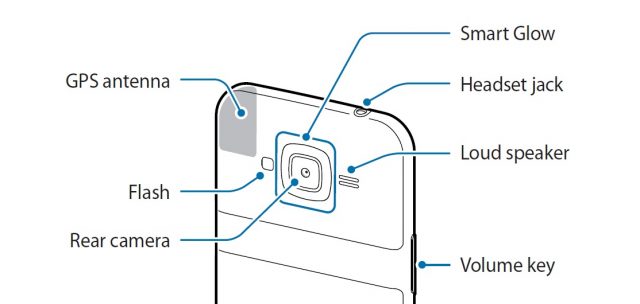
A new type of LED notification system will be featured in the upcoming Galaxy J2 (2016) as per reports. In fact, we may begin to see this feature embedded in all future Samsung smartphones soon enough. The news was shared by GalaxyClub.nl after they found the feature mentioned in the upcoming J2's leaked manual.
The hardware of the Smart Glow feature is a pretty simplistic LED ring that's capable of flashing in various colors. As you can see in the image, the ring will be encompassing the rear camera module of the phone. Now, the usefulness of the LED ring lies in its functionalities and here are the ones we know about at this time.
1. You will be able to set specific colors for specific contacts, so when a notification arrives, you will know who it is from, even without turning the phone around and from a distance.
2. It will indicate low battery like regular LED notifiers do.
3. The Smart Glow will enable the user to take efficient selfies with its rear camera as well, because it will emit a blue light as soon as the subject's face is within the sensor's viewfinder.
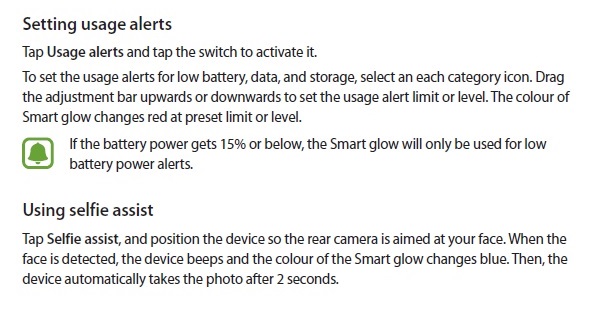
Personally, we like the last one the most and users will probably find it to be the most useful as well.
Author: Saikat Kar (tech-enthusiast)
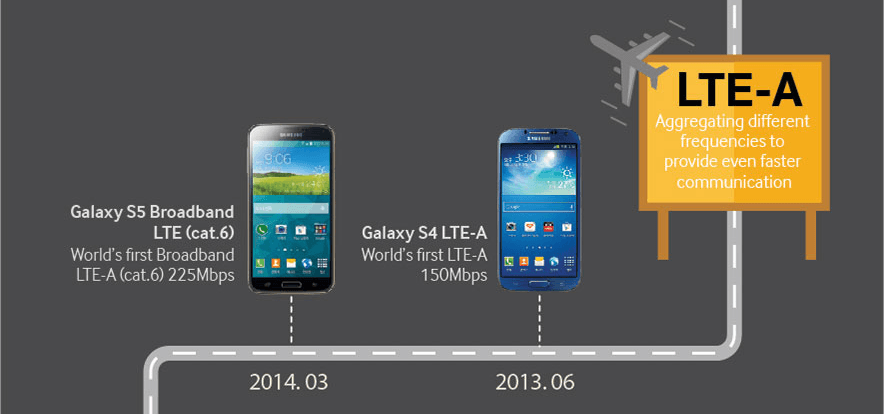
Today, Samsung released an Infographic that showcases the Evolution of communication technology starting from 1st Generation (1G) to the 4th Generation (4G LTE-A) smartphones.
The infographic first presents the Samsung SH-100, a bulky device that was launched way back in 1988 as Samsung's very first mobile phone. It then takes us through the mid 1990s (with the Samsung SCH-100, the world's first commercialized CDMA phone), and through the early 2000s (when the SCH-E100 was released as the world's first 3G, 1X EV-DO handset).
Not long after that, HSDPA became available at about the same time with the rise of smartphones. Next was LTE, however, the world's first LTE-capable handset wasn't a smartphone: it was the Samsung SCH-R900, a featurephone with a WVGA touchscreen display and a sliding QWERTY keyboard. The Galaxy S II, Galaxy S III, Galaxy S4 LTE-A, and the Galaxy S5 Broadband LTE are also mentioned.

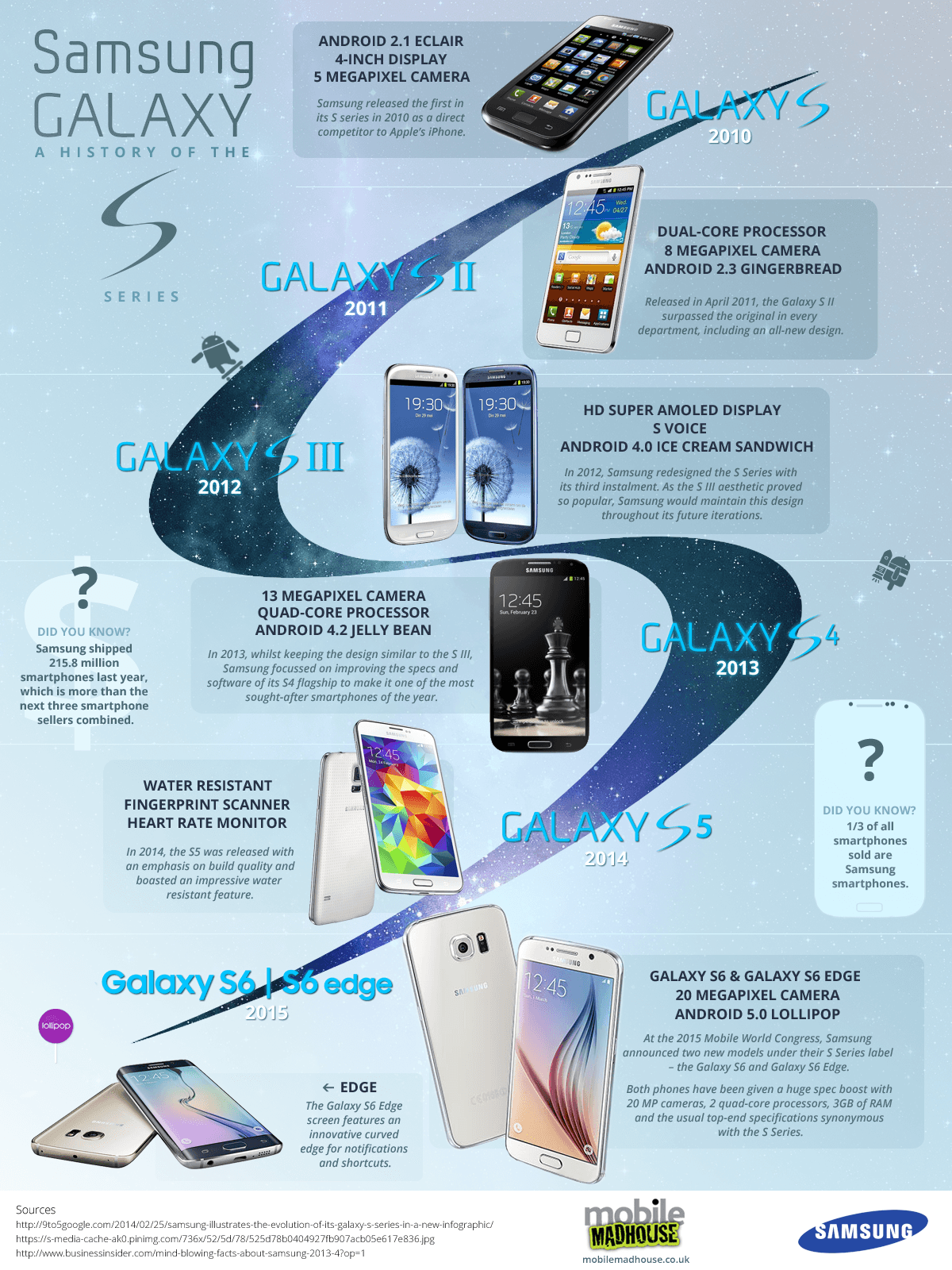
The Samsung Galaxy S line has started off with the Samsung Galaxy S release in 2010, Here we are in 2015 and We have the first Curved Galaxy S Smartphone.
Gathering all this in one Photo will give you a look at the Big picture of how Samsung came a long way with its technology on improving the line in the past 5 years.
The Infographic above shows how the Samsung Galaxy S line started with the OG phone sporting a 4 inch, Super AMOLED screen and powered by a 1GHz processor. The Samsung Galaxy S6 features a 5.1 inch Quad HD Super AMOLED display, powered by a homegrown Exynos 7 Octa chipset. Along the way, the rear-facing camera has gone from 5 MP to 16 MP with OIS tech, while the RAM amount went from 1 GB to 3 GB.
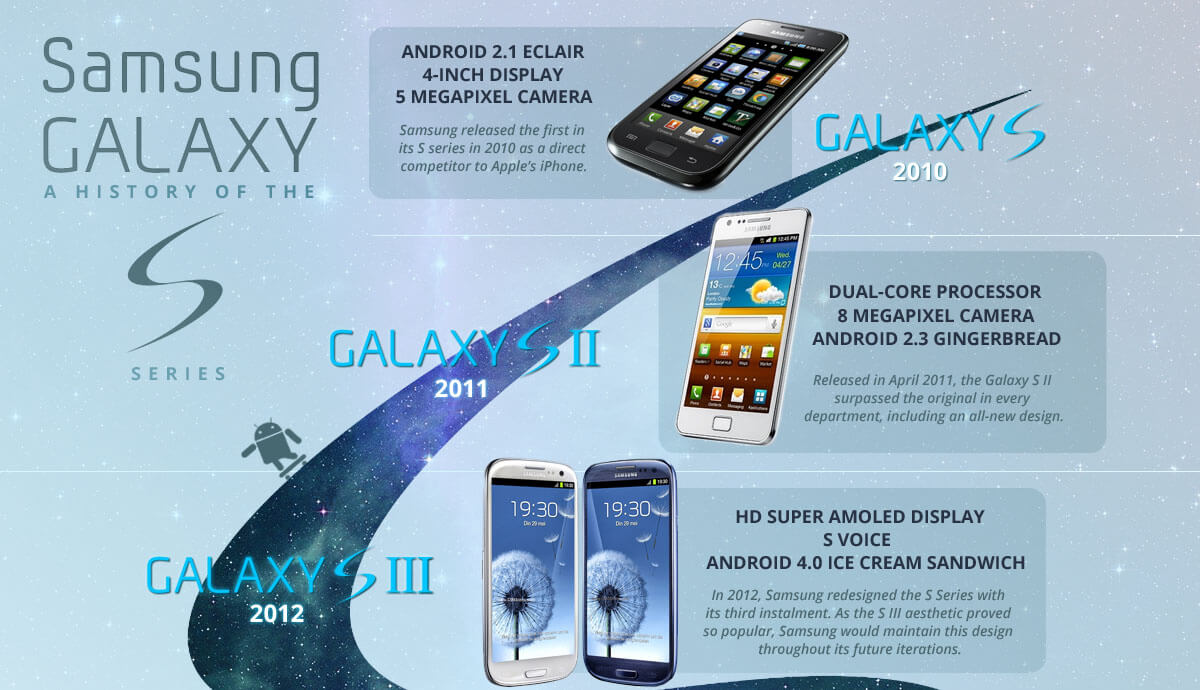
Samsung today posted a video that presents the evolution of its Galaxy S flagship smartphones, from the original Galaxy S to this year's Galaxy S6 and Galaxy S6 edge.
As some of you may remember, the very first Samsung Galaxy S was launched in the first half of 2010. With its 4-inch WVGA (480 x 800) display and its single-core 1 GHz processor, the Galaxy S is obviously a low-end device by today's standards. Next year, in 2011, the Galaxy S II introduced a dual-core 1.2 GHz processor and a larger, 4.3-inch display, though the pixel resolution remained unchanged. The Galaxy S III (2012) brought us a quad-core processor and a 4.8-inch 720p display, while the Galaxy S4 (2013) was the first in the series to offer a 1080p display (a 5-inch). Last year's Galaxy S5 came with a 5.1-inch 1080p display, a water-resistant body, heart rate sensor, fingerprint scanner, and a 16 MP rear camera.
Finally, Samsung's current flagships, the Galaxy S6 and S6 edge, offer 5.1-inch Quad HD (1440 x 2560) displays, octa-core Exynos processors, 3 GB of RAM, up to 128 GB of storage space, and bodies made out of metal and glass. Unlike the regular S6, the S6 edge features a dual curved screen which differentiates it from all other smartphones out there.

Samsung's Galaxy S line has started off with the Samsung Galaxy S release back in 2010... And Here we are in 2015, we have the first Curved Galaxy S Smartphone, Galaxy S6.
Gathering all this in one Photo will give you a look at the Big picture of how Samsung came a long way with its technology on improving the line in the past 5 years.
The Infographic above shows how the Samsung Galaxy S line started with the OG phone sporting a 4 inch, Super AMOLED screen and powered by a 1GHz processor. The Samsung Galaxy S6 features a 5.1 inch Quad-HD Super AMOLED display, powered by a homegrown Exynos 7 Octa chipset. Along the way, the rear-facing camera has gone from 5 MP to 16 MP with OIS tech, while the RAM amount went from 1 GB to 3 GB.

Google improved Android's market App a lot since the launch of Android 1.0 on 2007 and its re-branding to Google Play Store. We gathered some screenshots of the Market app from Android market v1.0 to the Google Play store App v5.0 that was released yesterday. Google done a great job on improving the UI of the App.
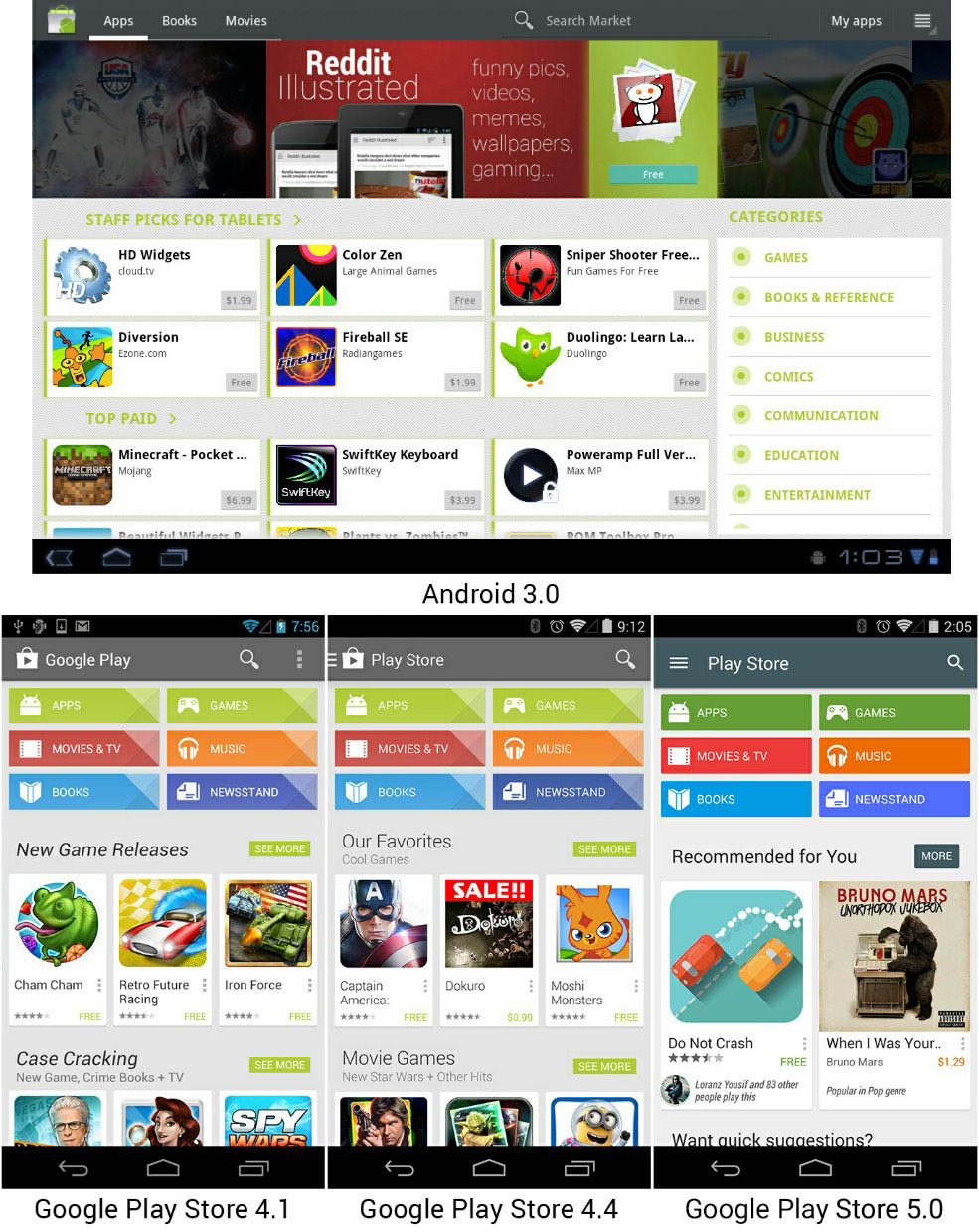

SMS Text Messages was first invented in 1992. Nowadays, SMS text is a very popular thing, even if it's a regular
SMS texts or through Viber, WhatsApp, Facebook Messenger, iMessage ...etc. modern people are seemingly putting texting on top of all other forms of communication that their mobile gadgets are offering.
Thanks to a new Infographic by Neon SMS, we get to explore the history of texting, from the inception of the SMS to its current state. Indeed, the above-mentioned messaging services are a pretty harsh competition to regular SMS texts, but the latter are certainly here to stay. Check it out!

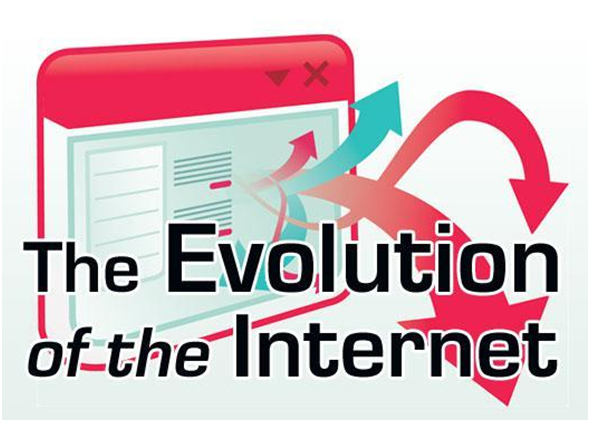
The Internet has changed so many things we do these days, and we tend to take it for granted. Here are some things that the evolution of the Internet has changed in our lives:
1. The Web of Information - There is so much information at our fingertips these days, and we instantly have access to it. Gone are the days of having to go through numerous libraries looking for information, when all we need to do is to go on the Internet.
2. Add-Ons Making Our Lives Easier - When writing, searching the Internet, or even communicating with people, add-ons have been revolutionary. Creating a web of trust for us, and helping us avoid malicious sites, it seems we can't live without add-ons these days.
3. Online Gaming - All modern consoles and desktop computers are connected to the Internet and allow us to play with people from all over the world. We tend to take them for granted these days, but where would we be without the ability to compete against each other?
4. Twitch and YouTube - The ability to stream our gameplay and watch others playing is growing in popularity, especially with eSports. Imagine how hard it was to do that in the past? We did have old shows like Gamesmaster, but not live and not instantly at hand.
5. Netflix and Chill - Streaming our favourite movies and television show is something we all love to do. Binge-watching now means simply selecting what we want to watch, instead of continually having to change the VHS/DVD/Blu-ray after every few episodes.
6. Online Shopping - The ability to purchase anything we want and have it sent to our homes is something we take for granted now. Many would argue that this is one of the best evolutions of the Internet and what it has done for us.
7. Improved Customer Support - Gone are the days of having to pay telephone charges to get help, with customer support being available on the Internet. With live chats with people ready to help, it seems that getting help has never been easier.
8. The Power of the New Media - News has gone through a revolution with live streaming from phones and other devices. Gone are the days when we were reliant on television news show, as the Internet provides news instantaneously to us all.
9. Accountability - The Internet has helped us to hold people with authority to account. Gone are the days when governments try to hide facts, with the Internet bringing protesters together to work for the good of the people. There may be dangers of "fake news" but most of us see through that quickly.
10. The Smart Phone - The Internet is in the palm of our hands wherever we go. What better evolution of the Internet than this instant access from anywhere around the world?
The Internet continues to evolve and get better and better. We reap the rewards of the technical advances we see every day, and the list above are just a few ways our lives have been improved.
In a world where technology is ever-evolving, its impact on every facet of life is undeniable. Education, a cornerstone of societal development, has not been immune to this digital revolution. As we delve into how technology has transformed learning, it's crucial to understand the magnitude of this change. From the traditional chalkboard to virtual classrooms, the journey reflects a paradigm shift in how knowledge is acquired, processed, and disseminated. This article aims to unravel the intricate ways in which technology has redefined the educational landscape, preparing learners for a future where digital fluency is as essential as literacy and numeracy. At the heart of this transformation lies the concept of the digital learner - a generation that has grown up amidst a flurry of gadgets, apps, and the internet. Their approach to education is vastly different from their predecessors, molded by the rapid pace and accessibility of information. As we explore the nuances of this change, it's important to note that technology's influence extends beyond mere tools for learning or using one of the different paper writing service; it reshapes the very fabric of educational methodologies, learner engagement, and the skill sets required for the future. Let's embark on this journey to understand how technology has changed the way we learn and what it means for the future of education. In the digital age, students, often referred to as digital natives, have grown up in an environment where instant connectivity and access to information are the norms. This has fundamentally altered their approach to learning. Unlike previous generations, digital learners are adept at navigating the online world, filtering vast amounts of information, and adapting to various digital platforms. Their learning style is characterized by a preference for interactive and multimedia-rich content. The integration of technology in education has led to the development of innovative learning tools and platforms. Online courses, interactive apps, and virtual classrooms have become prevalent, offering flexibility and access to a wealth of resources. This shift has enabled personalized learning experiences, where students can learn at their own pace and according to their interests and needs. Social media platforms and digital communication tools have become central to the learning experience, offering new and dynamic ways for students to engage with content, educators, and peers. They facilitate a collaborative environment, where learners can share resources, discuss ideas, and receive feedback in real-time. These platforms also support diverse learning styles, allowing for visual, auditory, and interactive content, which can enhance understanding and retention. Moreover, social media extends learning beyond the classroom, enabling continuous engagement and fostering a community of learners connected by shared interests and educational goals. This shift has not only democratized access to information but also cultivated digital literacy skills, critical for success in today's digital world. Social media and digital communication tools have revolutionized the way students interact with their peers and educators. These platforms have facilitated collaborative learning, peer-to-peer support, and a more inclusive educational environment. They have also altered the traditional teacher-student dynamic, paving the way for more interactive and engaging educational experiences. Today's learners expect immediate feedback and interactive learning experiences. Technology has catered to this need by providing tools that offer real-time feedback, gamified learning experiences, and interactive simulations. This immediacy not only enhances engagement but also allows for more effective tracking of progress and understanding. Despite the benefits, the integration of technology in education is not without challenges. There is a need to ensure equitable access to technology, to address privacy and security concerns, and to develop digital literacy skills among both educators and students. Additionally, it's important to balance technology use with traditional learning methods to maintain a well-rounded educational experience. The landscape of education is continually evolving with technological advancements. These changes bring exciting opportunities for enhanced learning experiences but also necessitate careful consideration of the challenges. As we move forward, it's crucial to adapt and innovate in our educational approaches, ensuring that we harness the potential of technology to empower learners in this digital age.
1. The Advent of the Digital Learner
2. Technology's Role in Learning Enhancement
3. The Impact of Social Media and Digital Communication
4. The Need for Instant Feedback and Interactive Learning
5. Challenges and Considerations
Conclusion
 |
 |
|
this article is not available |
||
 |
 |

Ask any gambler what pops into their head first when they hear the word casino. The answer will come as no surprise. Most probably describe modern Las Vegas-style casino resorts, with flashy gaming tables, glamourous dealers and hundreds of slot machines. Some might speak of today's online casinos that let you play and win cash anywhere, anytime.
But we bet no one will describe anything like the world's earliest casinos. That's because, since the first casino opened its doors in 1638, the casino - and the way we play casino games - has changed almost beyond recognition. New gambling laws, advancements in technology, busier lifestyles and even investment from the Mafia are just some of the factors that have helped to turn the casino from what is was back then into what it is today.
Interested in finding out more about the evolution of the casino? Take a look at the below infographic, put together with the help of the guys from the online casino bgo.com.
© 2023 YouMobile Inc. All rights reserved






